
VICTORY COAL MINE-WABAMUN-c.1940
-Looking approximately North-West
What happened with the coal before it came to the surface?
Go
UNDERGROUND to find out.
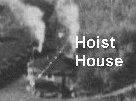 Hoist House- Steam powered, two drums working opposite to each other pulled two cables into the mine shaft and around a "Bull Wheel" at the far end of the shaft (the parting) where the mine cars were collected to be pulled out of the mine in trips of about twenty, each carrying about one ton of coal. The cars were coupled together and the hoist rope attached to the front and the tail rope to the back end of the string. The rope rider rode on the back car and signalled the hoist operator in the hoist house with a system of buzzers which were operated by shorting a pair of bare wires running on the roof above the tracks. These wires were also the telephone line from the hoist house to the "parting". Inside the mine the shaft ran up and down hills as on the surface as the shaft followed the curves of the coal seam so it was the hoist operators skill to know when to pull the cable and when to slack it off to keep the trip rolling steadily toward the entrance. The track was doubled between the hoist house and the tipple, a line of empty cars can be seen to the left of the hoist house. The loaded cars will come out on the other track, the cables detached from each end and hooked up to these cars and pulled back into the mine. Inside the mine the horses would move the cars around in the side shafts, moving empties in and loaded ones to the "parting" to make up the trip. At the tipple the cars were moved around using a single horse and the coal was dumped into the tipple.
Hoist House- Steam powered, two drums working opposite to each other pulled two cables into the mine shaft and around a "Bull Wheel" at the far end of the shaft (the parting) where the mine cars were collected to be pulled out of the mine in trips of about twenty, each carrying about one ton of coal. The cars were coupled together and the hoist rope attached to the front and the tail rope to the back end of the string. The rope rider rode on the back car and signalled the hoist operator in the hoist house with a system of buzzers which were operated by shorting a pair of bare wires running on the roof above the tracks. These wires were also the telephone line from the hoist house to the "parting". Inside the mine the shaft ran up and down hills as on the surface as the shaft followed the curves of the coal seam so it was the hoist operators skill to know when to pull the cable and when to slack it off to keep the trip rolling steadily toward the entrance. The track was doubled between the hoist house and the tipple, a line of empty cars can be seen to the left of the hoist house. The loaded cars will come out on the other track, the cables detached from each end and hooked up to these cars and pulled back into the mine. Inside the mine the horses would move the cars around in the side shafts, moving empties in and loaded ones to the "parting" to make up the trip. At the tipple the cars were moved around using a single horse and the coal was dumped into the tipple.
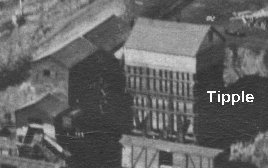 Tipple/Screening Plant-Cleaning, sorting for size and type, and storage of coal for shipment, usually by boxcar to Edmonton. There were also some local sales but this was a small part of the operation and the trucks or wagons could only be loaded when it didn't interfere with loading boxcars. The tipple operator or his assistant weighed each of the cars on the scale built into the track and recorded the number of the brass tag attached by the miner to be credited for pay. The car was then pushed onto a tilting table, a hook was attached to the top of the gate, and the table was tilted, dumping the car. It was then pushed back and switched onto the return track and the horse pulled it back for coupling onto the empty trip.
Tipple/Screening Plant-Cleaning, sorting for size and type, and storage of coal for shipment, usually by boxcar to Edmonton. There were also some local sales but this was a small part of the operation and the trucks or wagons could only be loaded when it didn't interfere with loading boxcars. The tipple operator or his assistant weighed each of the cars on the scale built into the track and recorded the number of the brass tag attached by the miner to be credited for pay. The car was then pushed onto a tilting table, a hook was attached to the top of the gate, and the table was tilted, dumping the car. It was then pushed back and switched onto the return track and the horse pulled it back for coupling onto the empty trip.
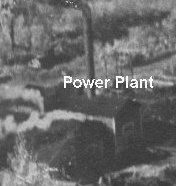 Power Plant- Steam for running the hoists (that's a steam pipe running up the hill), and heating water for the wash house, electricity for the mine lights, pumps and ventilation system and to operate the coal cutting machine. Also provided electricity for the tipple. There were tracks laid down from under the north side of the bins at the tipple to the power house to carry slack (fine) coal to fire the boilers. In the picture a mine car can be seen on this track. Since this was a small operation the engineer fired the boilers as well as maintaining them. Water for the boilers was pumped out of the mine and ran in a pipeline to the power house, any excess was vented to a culvert under the tracks.
Power Plant- Steam for running the hoists (that's a steam pipe running up the hill), and heating water for the wash house, electricity for the mine lights, pumps and ventilation system and to operate the coal cutting machine. Also provided electricity for the tipple. There were tracks laid down from under the north side of the bins at the tipple to the power house to carry slack (fine) coal to fire the boilers. In the picture a mine car can be seen on this track. Since this was a small operation the engineer fired the boilers as well as maintaining them. Water for the boilers was pumped out of the mine and ran in a pipeline to the power house, any excess was vented to a culvert under the tracks.
Pit Props-Seven foot long spruce, sometimes poplar, logs six inches diameter at the small end. Used to shore up the diggings, one on each side and one across the top wherever necessary. Cut by locals in the area and delivered to the mine site a sleigh load at a time (about 50 pieces) they were hauled into the mine on special cars, many thousands were used. Some 13 foot pieces were also purchased to be used at wider places in the mine, also three foot pieces, squared on two sides with a broadaxe, to be used as ties for the tracks. All of this wood was cut by hand using a crosscut saw (misery whip) in the winter time and delivered by horse and sleigh to the mine.
Barn- (out of the picture to the left and up from the Wash House) To house the many horses which were used in and around the mine.
Blacksmith Shop- Forge and heavy tools for metalworking, of which there was plenty. Also for shoeing the mine horses and doing harness work. Jacob "Jack" Koflick was the blacksmith at the old mine for many years, a skilled trade and vital to the operation. All the mine horses had to be shod on a regular basis, tracks, switches and all the hoisting machinery welded and maintained, and the tipple machinery kept operational. To do this he had a coke-fired forge and anvil, his hammers and wrenches and a few machine tools, all powered by a single electric motor at one end of his workbench connected by a belt to an overhead shaft which drove other belts to power the grinder, drill press, etc., and also, I believe, a fan for the forge.
The blacksmith shop, which you can see in the picture just north of the office, was painted barn red with white trim, although those colours were pretty well faded by my time. My remembered guesstimate has it about 16 by 24 feet, with a dirt floor. The workbench was along the west wall to the south end (with a large window over it) and the big forge was on the west wall toward the north end. On the east wall opposite the forge was a large set of double doors for the horses. There was a regular passage door in the southeast corner.
 Cookhouse (built 1914)-(approx.30'x60') and dining hall, also residence for the cook and helpers. One large dining room with tables and benches and behind that a huge kitchen with coal fired stoves and ovens, sinks for washing and counters along the wall for food preparation
Cookhouse (built 1914)-(approx.30'x60') and dining hall, also residence for the cook and helpers. One large dining room with tables and benches and behind that a huge kitchen with coal fired stoves and ovens, sinks for washing and counters along the wall for food preparation
Wash House (built 1923)-Endless showers of hot water, mining is a dirty business. A steam line from the powerhouse coiled through the water tank to heat water. Each miner had his place on the benches along the walls. Above this area was a grapnel arrangement on a chain which could be let down to hang mining clothes, towels and soap (usually in a tobacco can), then raised out of the way. As kids we spent a lot of time in the wash house, taking showers and playing in the water when there were no miners to annoy.
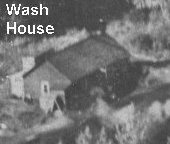
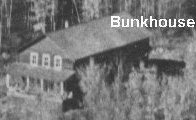 Bunk House (built 1914)-(approx.80'x30') Divided into twenty-two rooms plus a large common room and verandah on the main floor. Some of the workers stayed here all the time and took all meals at the cook house. Some stayed while they were on shift and went home on the weekends. There was a coal fired gravity furnace in the basement for heat. The only other furnace in camp was in the manager's house. All the other houses relied on the kitchen cook stove and coal-fired heaters to stay warm through the winters. We had a BOOKER self stoker and my uncle had a WARM MORNING. My mother would be up several times a night to keep the heater burning, I remember on cold winter nights when there was no other light how the heater would glow cherry red in the living room. In the morning before school we would take our clothes out to huddle by the BOOKER and warm up as we dressed.
Bunk House (built 1914)-(approx.80'x30') Divided into twenty-two rooms plus a large common room and verandah on the main floor. Some of the workers stayed here all the time and took all meals at the cook house. Some stayed while they were on shift and went home on the weekends. There was a coal fired gravity furnace in the basement for heat. The only other furnace in camp was in the manager's house. All the other houses relied on the kitchen cook stove and coal-fired heaters to stay warm through the winters. We had a BOOKER self stoker and my uncle had a WARM MORNING. My mother would be up several times a night to keep the heater burning, I remember on cold winter nights when there was no other light how the heater would glow cherry red in the living room. In the morning before school we would take our clothes out to huddle by the BOOKER and warm up as we dressed.
 Office- Manager and timekeepers office. Also warehouse.
Office- Manager and timekeepers office. Also warehouse.
Houses- Residences for the Mine Manager, Engineer, Office Manager and some others were on top of the hill. The one just below the Cookhouse, with additions built by my father on every side, was my home for twelve of my formative years.
Underground mining took place 1913-1948. Surface or open pit mining on a small scale using earth movers, loaders and dump trucks and the same tipple (enlarged) from 1948-1963. Surface mining on a larger scale, using large draglines and coal-haulers, to supply the thermal-electric generators at Wabamun continues to this day.
Victory Coal Mine Picture
Victory Coal Mine - History
Life in Shanty Town

"If a man works in a coal mine and can't steal enough coal to keep warm, there's something wrong with the world." -anonymous
 Hoist House- Steam powered, two drums working opposite to each other pulled two cables into the mine shaft and around a "Bull Wheel" at the far end of the shaft (the parting) where the mine cars were collected to be pulled out of the mine in trips of about twenty, each carrying about one ton of coal. The cars were coupled together and the hoist rope attached to the front and the tail rope to the back end of the string. The rope rider rode on the back car and signalled the hoist operator in the hoist house with a system of buzzers which were operated by shorting a pair of bare wires running on the roof above the tracks. These wires were also the telephone line from the hoist house to the "parting". Inside the mine the shaft ran up and down hills as on the surface as the shaft followed the curves of the coal seam so it was the hoist operators skill to know when to pull the cable and when to slack it off to keep the trip rolling steadily toward the entrance. The track was doubled between the hoist house and the tipple, a line of empty cars can be seen to the left of the hoist house. The loaded cars will come out on the other track, the cables detached from each end and hooked up to these cars and pulled back into the mine. Inside the mine the horses would move the cars around in the side shafts, moving empties in and loaded ones to the "parting" to make up the trip. At the tipple the cars were moved around using a single horse and the coal was dumped into the tipple.
Hoist House- Steam powered, two drums working opposite to each other pulled two cables into the mine shaft and around a "Bull Wheel" at the far end of the shaft (the parting) where the mine cars were collected to be pulled out of the mine in trips of about twenty, each carrying about one ton of coal. The cars were coupled together and the hoist rope attached to the front and the tail rope to the back end of the string. The rope rider rode on the back car and signalled the hoist operator in the hoist house with a system of buzzers which were operated by shorting a pair of bare wires running on the roof above the tracks. These wires were also the telephone line from the hoist house to the "parting". Inside the mine the shaft ran up and down hills as on the surface as the shaft followed the curves of the coal seam so it was the hoist operators skill to know when to pull the cable and when to slack it off to keep the trip rolling steadily toward the entrance. The track was doubled between the hoist house and the tipple, a line of empty cars can be seen to the left of the hoist house. The loaded cars will come out on the other track, the cables detached from each end and hooked up to these cars and pulled back into the mine. Inside the mine the horses would move the cars around in the side shafts, moving empties in and loaded ones to the "parting" to make up the trip. At the tipple the cars were moved around using a single horse and the coal was dumped into the tipple.




